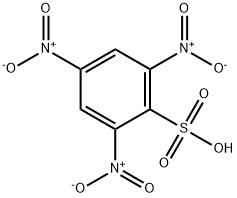LN9279727
2,4,6-trinitrobenzenesulfonic acid , 5%(w/v)inH2O , 2508-19-2
Synonym(s):
2,4,6-Trinitrobenzenesulfonic acid solution;TNBS
CAS NO.:2508-19-2
Empirical Formula: C6H3N3O9S
Molecular Weight: 293.17
MDL number: MFCD00064382
EINECS: 219-717-7
Update time: 2022-07-08
PRODUCT Properties
| Density | 1.14 g/mL at 20 °C |
| refractive index | n |
| Flash point: | 58 °C |
| storage temp. | 2-8°C |
| pka | -3.05±0.50(Predicted) |
| BRN | 572358 |
| InChI | InChI=1S/C6H3N3O9S/c10-7(11)3-1-4(8(12)13)6(19(16,17)18)5(2-3)9(14)15/h1-2H,(H,16,17,18) |
| InChIKey | NHJVRSWLHSJWIN-UHFFFAOYSA-N |
| SMILES | C1(S(O)(=O)=O)=C([N+]([O-])=O)C=C([N+]([O-])=O)C=C1[N+]([O-])=O |
| CAS DataBase Reference | 2508-19-2(CAS DataBase Reference) |
| EPA Substance Registry System | Benzenesulfonic acid, 2,4,6-trinitro- (2508-19-2) |
Description and Uses
Hydrophilic modifying reagent. Derivatives with amino compounds can be regenerated with hydrazine.', 'Picrylsulfonic acid solution has been used:
- to assess the efficiency of carboxymethyl lysine (CML) modifications of exposed primary amines
- to incubate zona intact bovine embryos for the differential staining of blastocysts
- to induce irritable bowel syndrome (IBS) in mice and to study its effects on Clostridium butyricum
Safety
| Symbol(GHS) |   GHS05,GHS07 |
| Signal word | Danger |
| Hazard statements | H314-H317 |
| Precautionary statements | P261-P272-P280-P303+P361+P353-P304+P340+P310-P305+P351+P338 |
| Hazard Codes | T,Xn,C,F |
| Risk Statements | 61-20/21-36-43-36/38-22-1-34-25-11 |
| Safety Statements | 53-26-36/37-45-36/37/39-16-35 |
| RIDADR | UN 3265 8/PG 3 |
| WGK Germany | 1 |
| RTECS | DA9138500 |
| HazardClass | 1.1D |
| PackingGroup | Ⅱ |
| Hazardous Substances Data | 2508-19-2(Hazardous Substances Data) |



